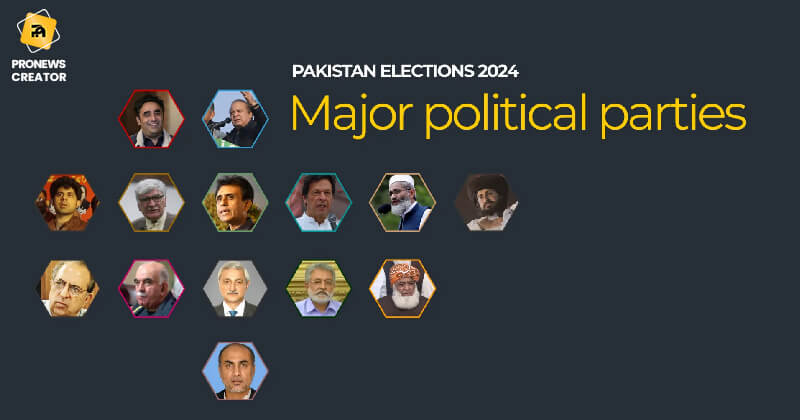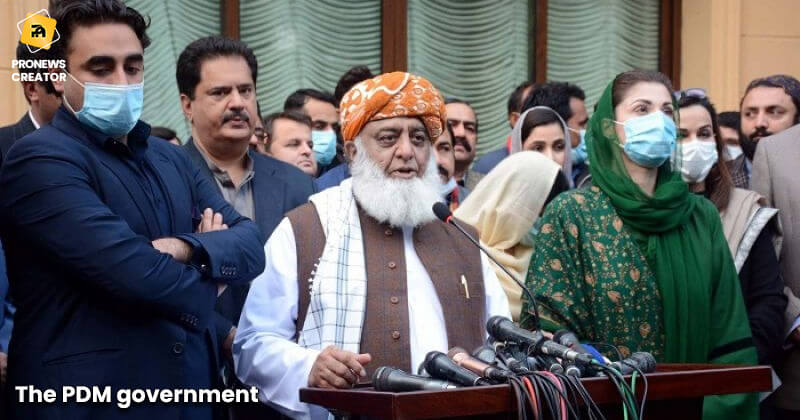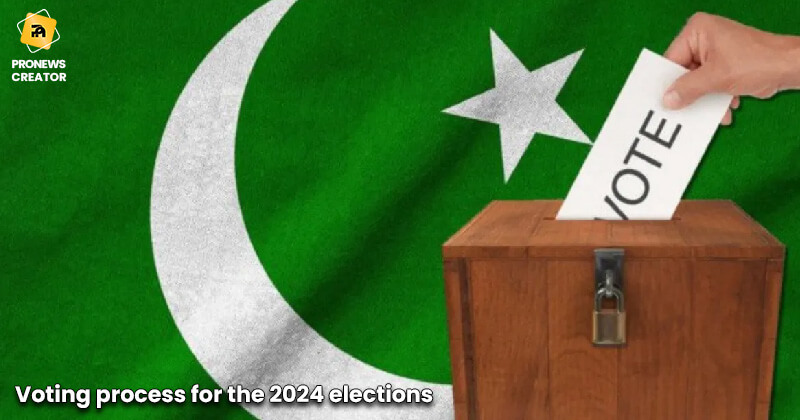Pakistan will vote for national and state legislatures on February 8, under political uncertainty and severe economic hardships.
On Thursday, 128 million Pakistanis will vote to decide the country’s upcoming government as well as the legislatures of its four provinces.
Pakistan will hold general elections on February 8, 2024, to elect members of the 16th National Assembly.
The Election Commission of Pakistan issued the detailed schedule on December 15, 2023.
A record 1300 complaints have been lodged around the country about the election process, particularly the suggested move to unite two districts in Balochistan, even though they are 400 miles apart and have no road links.
About the elections of 2024
These are Pakistan’s 12th general elections and the latest try to support its democratic origins.
Pakistan’s challenging military establishment has dominated instantly for around three decades since the country gained independence in 1947.
It has influenced and intervened in politics even when not directly in power, as former army leader Qamar Javed Bajwa acknowledged in November 2022.
General Asim Munir, the chief of the Pakistan Army, will solidify his power over the country’s political leadership during the 2024 election.
The elections are notable because, for the first time in Pakistani history, the favor of a civilian leader (Imran Khan) has challenged the Army’s control.
Nawaz Sharif has taken Imran Khan’s position in jail since police arrested him in 2017 on corruption accusations.
The PML chief managed to flee the nation and returned only in October 2023, when all charges against him evaporated into thin air.
The much-delayed elections were assumed to take place in November 2022, following the conclusion of the National Assembly’s term on August 12, Supreme Court handled the matter, where the ECP submitted a report on conducting the elections on February 8, after consulting with the President.
According to census data, the overall number of voters climbed to 128 million as of July 25, 2023, up from 106 million in 2018, representing a 21 million rise over the previous five years.
Major political parties in elections

The three primary candidates for the 2024 elections are Imran Khan’s PTI, Nawaz Sharif’s PLM-N, and Bilawal Bhutto Zardari’s Pakistan People’s Party (PPP).
The two biggest political groups are the Pakistan Muslim League (N) (PML-N), led by former Prime Minister Nawaz Sharif, and the Pakistan Peoples Party (PPP), led by former Foreign Minister Bilawal Bhutto Zardari.
The Pakistan Tehreek-e-Insaf (PTI), formed by Imran Khan, was the largest party in the last elections.
However, it fielded candidates as Independents following a contentious Supreme Court decision that stripped them of their electoral emblem to the elections.
The claims about the military’s involvement in politics have grown in recent weeks, coinciding with a crackdown on former Prime Minister Imran Khan and his Pakistan Tehreek-e-Insaf (PTI) party.
Khan is imprisoned and unable to run for office, and the PTI cannot use its electoral symbol, the cricket bat.
However, civilian leaders have ruled directly for 16 years, the longest period in independent Pakistan’s history.
Background of the 2018 elections
Pakistan held general elections on Wednesday, July 25, 2018, following the expiration of the outgoing government’s five-year tenure.
At the national level, elections were in 272 constituencies, with each party elected one member of the National Assembly.
Provincial elections were held in each of the four provinces to elect Members of Provincial Assemblies (MPAs).
Following the elections, the Pakistan Tehreek-e-Insaf (PTI) emerged as the single largest party at the national level in terms of popular vote and seats.
At the provincial level, the PTI remained the largest party in Khyber Pakhtunkhwa (KP); The Pakistan People’s Party (PPP) remained the largest party in Sindh, while the newly established Balochistan Awami Party (BAP) became the largest party in Balochistan.
In Punjab, a hung parliament prevailed, with the Pakistan Muslim League (N) (PML-N) winning the most directly elected seats by a slight margin.
However, with the backing of the Pakistan Muslim League (Q) and the addition of independent MPAs to the PTI, the latter became the largest party and was able to establish the government.
The PDM government

Following the victory of the no-confidence motion on 11 April 2022, Shehbaz Sharif became Prime Minister after winning 174 votes out of a total of 342.
It happened with the assistance of the Pakistan People’s Party, Jamiat Ulema-e-Islam, and several smaller parties affiliated with the Pakistan Democratic Movement (PDM).
The alliance secured two more than the required majority.
Dissident members of the PTI also backed his candidature.
Meanwhile, the remaining PTI partners, who were now in opposition, boycotted the session, calling it a continuation of a “foreign conspiracy”.
More than 100 PTI members resigned from their National Assembly centers after one day.
The PDM government remained in power until August 10, 2023. During Sharif’s term, the national economy tightened, inflation was historically high, and the devaluation of local currency to record levels.
Voting process for the 2024 elections

The votes will elect a government that will restore peace to a country plagued by a tumultuous political scene, rising violent occurrences, and a shaky economy.
Voters will also elect members of their provincial assemblies. In effect, each voter has two votes: one for the National Assembly and one for the Provincial Assembly.
The voting procedure will begin at 8 a.m. (03:00 GMT) and continue uninterrupted until 5 p.m. (noon GMT). Those in wait to vote at 5 p.m. will be permitted to vote, even if it delays the process.
If polling sites experience violence or other interruptions, officials may extend voting hours to allow voters to cast their ballots.
The counting will begin after voting ends, with preliminary results expected within a few hours.
Voters Detail
Out of a total population of 242,828,767, there are 127,415,319 registered voters throughout 266 National Assembly constituencies.
Punjab has 73,207,896 registered voters out of 127,688,922 people in provincial seats.
Sindh has 26,994,769 registered voters out of a total population of 55,696,147 living in the 130 Sindh Assembly constituencies.
Khyber Pakhtunkhwa has 21,928,119 registered voters out of a total population of 40,856,097 over 115 provincial seats.
Balochistan has 5,371,947 registered voters out of a total population of 14,894,402, divided into 51 Assembly seats.
Young voters
A concern is whether young voters will show out in large numbers on Election Day, February 8.
The highest electoral board issued the data, It shows that 23.51 million voters aged 18 to 25 and 33.34 million aged 26 to 35.
According to political commentators, the number of young voters who use social media may influence the electorate’s mood if they are on election day.
Polling Stations
According to the ECP, around 90,675 polling stations with 276,402 polling booths have been put up across the country under the polling scheme, serving 128 million voters.
Punjab has constructed 50,944 voting stations for the upcoming elections.
Sindh has 19,006 people.
Khyber Pakhtunkhwa (KP) has 15,697.
Balochistan has 5,028.
Provincial elections
The four provinces’ assembly – Balochistan, Khyber Pakhtunkhwa, Punjab, and Sindh – will elect lawmakers, who will then vote for a chief minister.
In proportion to its participation in the National Assembly, Punjab has the largest legislature, with 371 seats.
Sindh’s assembly has 168 seats, followed by Khyber Pakhtunkhwa (124 seats) and Balochistan (65).
Like the National Assembly, some seats in provincial legislatures are there for women and minorities.
These are divided proportionally among parties based on their representation in the legislature.
Distribution of seats in the National Assembly

The constituencies were due to the results of the 2023 national census.
The government adjusted many constituency borders, as did the number of seats in the National Assembly, which decreased from 272 to 266.
The northern Khyber Pakhtunkhwa province experienced a rise in seats from 39 to 45.
Punjab, the largest province by population, kept 141 seats.
Punjab, which accounts for more than half of the National Assembly seats, will be the most heated battleground on February 8.
Sindh, the country’s second-most populated province, and Balochistan, the poorest province, kept their original National Assembly seats of 61 and 16, respectively.
The Islamabad Capital Territory has three seats, just as it did previously. In addition, 60 seats are earmarked for women and 10 for minorities in the National Assembly, with allocation based on a 5 percent proportional representation.
Issues that the next government will face
The new government will face many challenges, including the country’s struggling economy, strengthening relations with neighboring Afghanistan, rehabilitating Pakistan’s infrastructure, fixing power outages, and increasing separatist militant organizations.
Final words
Pakistan’s 12.8 crore voters will elect a new government on Thursday, with the all-powerful Pakistan Army keeping a close eye on proceedings.
The primary competitors for the top office are Nawaz Sharif of the Pakistan Muslim League, Bilawal Bhutto-Zardari of the Pakistan Peoples Party, and Imran Khan’s Pakistan Tehreek-e-Insaf candidates. However, professionals say Nawaz Sharif has the Army’s blessing.
Unofficially, results begin to come in on the same night, and by early Friday morning, it will be evident who won. Election Commission officials will announce Official results on Friday.


